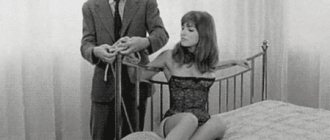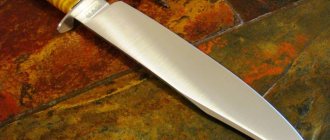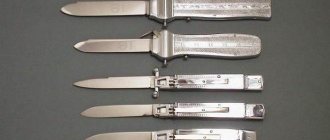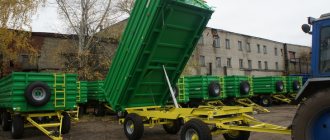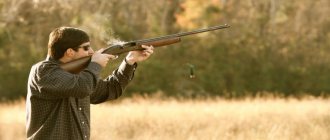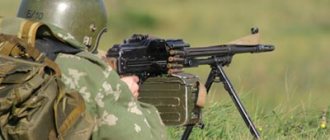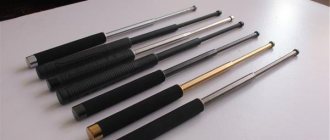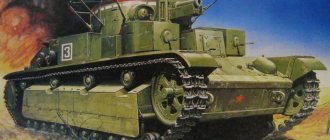Use of handcuffs
Handcuffs are an integral attribute of representatives of security and law enforcement agencies. Proper use of these special means allows you to quickly limit the physical ability of a detainee who is offering physical resistance or committing illegal actions. Classic handcuffs consist of two metal bracelets connected by two welded chain links. The locking part of the handcuffs allows them to be latched without using a key, and also to secure the latch from further squeezing.
The first handcuffs appeared quite a long time ago, immediately with the invention of iron. Of course, at first they did not at all resemble those that we see now among law enforcement officers and private security guards. They were simply pieces of iron connected by a chain. It is more correct to call such products shackles. They did not have locks; they were riveted by heating a pin over a fire, inserting it into the eyes of the bracelets and flattening the ends with a hammer. Of course, there were no keys either - there was a chisel and a hammer. In 1912, a revolution occurred in the production of handcuffs. Before this, to be honest, they most closely resembled a padlock. But Peerless engineers decided that this was not enough, and in order to shackle a person securely, an individual approach was needed. This is how a design appeared with a bow that rotated right through. Now handcuffs could be adjusted to the size of the hands of each individual person. In addition, the handcuffs used a ratchet mechanism, the principle of which was based on the fact that the upper arm of the handcuffs could rotate freely only in one direction, and back only if the ratchet was held by a key.
What are handcuffs?
Classic handcuffs consist of two metal bracelets connected by two welded chain links. The locking part of the handcuffs allows you to latch them without using a key, as well as to secure the latch from further unnecessary and even dangerous squeezing. The size of the handcuffs allows them to be used on as small a hand as desired (we are talking about adults), because... in the extreme position, the arms are compressed into an oval with sides of 5 and 4.5 cm, but they can also be snapped onto fairly large wrists or even onto the ankle. When worn on a belt, a cover is used to carry handcuffs.
Handcuffs “BR-S”, “BR-S2”, “BCS-1”, “BOS” are included in the list of special equipment used in private security activities.
BR-S operational handcuffs, two-link (complete with one key, fixed in a given position)
BR-S2 operational handcuffs, two-link (with a high-complexity lock, complete with two keys, fixed in a given position). The key is non-standard - flat, the flag is forked.
Handcuffs “BRS-2? Available in two versions, blued and nickel-plated, two-link, complete with two keys, with a lock of increased complexity, with fixation in a given position. Certificate of Conformity No. ROSS RU.SZ09.N00846; No. 0101351, Issued by: NPO “Tekhnika” of the Ministry of Internal Affairs of Russia. Weight: 380g. One of the advantages is that the latch is divided into two parts and there is a jumper between them in the lock, which makes it impossible to press both latches with something simple like a paperclip. Disadvantage - the keyhole comes out on both sides, which reduces the resistance to opening.
BKS-1 special convoy handcuffs, available in three modifications:
BKS-1? Tenderness-1? – special escort handcuffs with a connecting chain. They remain operational after applying a tensile load of at least 1500 N for 30 seconds. Semi-rigid hinged link fastening. Automatic latching. The transverse breaking force of the rotating bracket engagement is not less than 2500 N. The number of operations is not less than 5,000 cycles. The ratcheting mechanism of the products is made with a negative tooth engagement angle (with undercut), which ensures operation on the “shark tooth” principle. The increased angle of the rear sliding plane of the tooth guarantees easier snapping, increases the mechanical strength of engagement and wear resistance.
BKS-1?Prikol" – handcuffs with a stationary fastening
BKS-1?Bouquet” – escort handcuffs for 5 people
BOS operational special handcuffs (with a rigid system for attaching bracelets to each other)
Conditions for use and storage of handcuffs:
Operate at temperatures from -30 to + 40°C; The product must be stored in packaging indoors with an air temperature of +5 C to +40 C and a relative humidity of no more than 80%. It is recommended to periodically clean and lubricate the handcuffs according to the manufacturer's instructions. It is recommended to store the product in dry warehouses. Avoid joint storage with acids, alkalis and other substances that are aggressive towards metals. During operation, you should take into account the degree of structural rigidity and reliability of fixation of each type of handcuffs, determined by the type of locks and connecting devices between the bracelets.
Methods of handcuffing
Methods of using handcuffs are determined in the process of solving specific problems, for example, during delivery (accompanying, convoying) hands are cuffed. To prevent violent behavior, other, more stringent measures of movement restriction, including shackling of arms, legs and torso, may be used. As a rule, handcuffs are put on the hands behind the back (when the offender is transported, handcuffs are put on in the front position). Handcuffing is usually used after painful holds and throws or under the threat of a firearm.
Handcuffs can be placed on the opponent in a standing, lying, or kneeling position.
When handcuffing, regardless of the position of the opponent, a number of rules must be observed:
Before putting handcuffs on, you should, using force or the threat of force, force your opponent into a position that is convenient for their use and makes it difficult for him to attack you
the opponent must be pressed tightly with his chest and stomach to the ground, wall, etc.
To put on handcuffs, the hands are placed behind the back one by one, and a painful effect is applied to them
when putting on handcuffs, it is necessary that the locking device is adjacent to the inner surface of the wrist, and the sector is rotated in such a direction as to exclude the possibility of it getting caught on clothing or the body
When putting on handcuffs, you must be on the side of your opponent, out of reach of your legs. It is dangerous to handcuff only one of the detainee's hands while holding the other in your own hand, as he may use this position to strike. To more reliably restrict movement, the following hand positions are used when handcuffing (tying):
arms behind your back, hands one above the other
hands behind your back, hands pressed back to back
Author Vitaly Kukushkin
A little history
Without exaggeration, it can be said with a high degree of certainty that there have always been means of restricting human freedom. With the invention of iron, the first handcuffs appeared, which gradually replaced wooden blocks. The search for the optimal design of handcuffs was carried out in Europe and America. The English company Hiatt introduced the first handcuffs with a lock and key. They were called Darby (hand shackles). They were worn on both arms and legs, but had a significant drawback - their size was not adjustable. In 1862, engineers from the American Tower Company invented and patented handcuffs whose size could be adjusted.
The first Soviet handcuffs were made back in the 30s of the last century and were called “BR” - hand bracelets. They were modified, but, in general, no major design changes occurred.
The legal basis for the use of special means in Soviet times was the famous order of the Ministry of Internal Affairs of 1962, which allowed the police to use handcuffs.
How to use
The simple mechanism of the handcuffs allows you to use them without any special technical skills.
- Before putting on the rings of the handcuffs, they should be opened as wide as possible.
- After fixing on the hands, the rings snap into place and are placed in the required position, which ensures the reliability of their fixation.
The size of the handcuffs (their coverage) ensures a comfortable position of the hands in the rings; the smooth inner surface of the rings guarantees the absence of mechanical damage to the skin of the hands during fixation.
Automatically closed handcuffs connect the hands together and do not allow the attacker to perform any active actions. You must open the handcuffs using the key included in the kit: a mortise lock, which has an increased level of complexity, opens without any effort.
Read below about prices and reviews of handcuffs 1, 2, and 3 BRS.
During the administrative process, can they inspect a home and use special equipment?
Human rights lawyer Pavel Sapelko notes that the Code of Administrative Offenses does not stipulate specifically to which offenses certain rules of evidence apply. Therefore, for example, in an administrative case for insult on social networks, a citizen may be visited and inspected a house or apartment.
— The Code of Administrative Offenses lists all measures for collecting evidence. In particular, employees of the body conducting the administrative process have the right to conduct an inspection. How appropriate and proportionate is this to the offense committed? The Code of Administrative Offenses says nothing about this. Is the right to privacy of home violated? No, because it is subject to limitation if the inspection is carried out as part of due process of law.
The GUBOPiK can also conduct administrative proceedings, says the lawyer, although usually employees of this department are associated with much more serious cases.
- However, in fact they are employees of the Ministry of Internal Affairs. So if the case was considered important, they could pursue it.
Illustrative photo. Photo: Olga Shukaylo, TUT.BY
The use of special equipment, in particular handcuffs, is regulated by the Law on Internal Affairs Bodies, explains Pavel Sapelko.
— When assessing the expediency and legality of the use of handcuffs by employees of the Ministry of Internal Affairs, they do not proceed from what process is ongoing - administrative or criminal. They are based on the behavior of the citizen against whom special means are used. Handcuffs are used to detain and deliver to the internal affairs bodies suspects (accused) of committing crimes, persons against whom administrative proceedings are underway, only if they show disobedience or resistance.
Why was the protocol on an administrative offense drawn up by a senior police lieutenant of the Pervomaisky District Department of Internal Affairs of Minsk, but employees of the Main Directorate for Combating Organized Crime and Corruption of the Ministry of Internal Affairs participated in other procedural actions?
“Perhaps there were reasons why the inspection should have been carried out by the GUBOPiK unit,” explained briefly the official representative of the Ministry of Internal Affairs, Olga Chemodanova.
Let us remind you that for the second time this summer, law enforcement agencies have shown interest in bodybuilding champion Shota Lobzhanidze. The first time he was detained was on June 19 near the circus during the “Chain of Solidarity”, and on July 10, after a visit from law enforcement officers, the Pervomaisky District Court of Minsk considered an administrative case under Article 9.3 of the Code of Administrative Offenses “Insult”. According to Shota Lobzhanidze himself, the court imposed a fine of 20 basic units on him.
Specifications
| Specifications | BRS 1,2,3 |
| Type | hingeless |
| Dimensions in mm | 249x86x13 |
| Material | galvanized stainless steel |
| Keyholes | 2 pcs. |
| Ring circumference in mm | 75 |
| Distance between chain points in cm | from 5 to 10 |
| Weight in g | 380 |
| Additional features | painful hold |
BRS handcuffs are operational special equipment and have a two-link design.
This device is used to fix the arms in the rear position. BRS handcuffs are used by law enforcement agencies and security structures.
Rubber sticks in security activities: types, applications, limitations
The carrying and use of rubber truncheons by private security service employees has become a common occurrence for us today.
At the same time, not all Russian citizens have an accurate idea of the exact purpose of this special security equipment and its types. Also, few people have detailed information about the possibilities of using rubber batons by security guards and police officers and the legislative framework that regulates this area. Our article provides a detailed description of a rubber stick as a special security device.
Its main types and legal norms governing the use of a police baton are noted here.
The review also describes some techniques for effectively using a rubber stick as a weapon of self-defense. All information is provided by employees who have professional training and extensive experience in the use of rubber sticks and tonfas when providing security services in Moscow, St. Petersburg and Krasnodar.
How to pass testing for special equipment of a security guard of 4, 5, 6 categories
Testing a security guard for knowledge and use of special equipment is one component of the periodic inspection of a security guard. Although many will say at first glance that it is not so difficult, but judging by surveys, 85% of security guards who could not pass the test the first time “fail” on this test. Why is this happening? The reason is very simple. When you answer the theoretical tickets of the qualifying exam here, everything is simple, you just need to know the correct answer. In testing for knowledge and use of special equipment, tickets are also used, but you have to answer practically and here the “marketing frequency” of the inspectors is turned on, who often each have their own interpretation of the correct execution of a practical question, which often differs from the interpretation of execution set out in the orders of the Ministry of Internal Affairs. Another reason is the guard’s lack of knowledge of special equipment, who cannot, for example, distinguish a PR-K from a PR-73M. Let’s consider these issues in more detail:
In accordance with
Appendix No. 2 to the Regulations on the conduct of periodic inspections by internal affairs bodies of the Russian Federation of private security guards and employees of legal entities with special statutory tasks for suitability for action in conditions associated with the use of firearms and special means
STANDARD EXERCISES FOR THE PRACTICAL APPLICATION OF SPECIAL TOOLS, THE IMPLEMENTATION OF WHICH IS PROVIDED FOR PRIVATE GUARDS 4, 5, 6 CLASSES AND EMPLOYEES OF LEGAL ENTITIES WITH SPECIAL STATUTORY TASKS WHEN PASSING PERIODIC APPLIANCE CHECKS ACTIONS IN CONDITIONS RELATED TO THE USE OF SPECIAL MEANS
Exercise N 1: using a rubber stick
Procedure for performing the exercise
The person being tested is 1.5 meters opposite the dummy. The rubber stick is suspended on a belt. At the inspector’s command: “Start the exercise!” the person being tested removes the rubber stick from the suspension and strikes the dummy (at least six) in various areas allowed for impact with the rubber stick. After this, the person being tested reports: “The exercise has finished.” Time to perform the exercise: 20 seconds. When performing the exercise, blows must be applied in a fixed manner, without using excessive force that could damage the dummy. Positive result: performing at least six blows with a rubber stick on the dummy within the specified time , without allowing impacts to areas corresponding to areas of the human body that are not allowed to be impacted.
Exercise N 2: use of handcuffs
Procedure for performing the exercise
The person being tested is 1.5 meters opposite the dummy. The handcuffs are on the belt in a case. At the inspector’s command: “Put handcuffs in front (or behind)!” the person being checked takes the handcuffs out of the case, approaches the dummy, puts on the handcuffs and fixes their bracelets. After this, he reports: “The handcuffs are on.” Time to complete the exercise: 25 seconds. In the handcuffed state, the handcuffs should rotate freely and securely fix the limb. After checking that the handcuffs are put on correctly, at the inspector’s command: “Remove the handcuffs!”, the person being tested removes the handcuffs. Positive result : handcuffs were correctly put on within the specified time and then removed.
General requirements for performing exercises
Exercises No. 1 and No. 2 are performed on a mannequin, which should follow the contours of the human body. In this case, the upper limbs should imitate the structure of the hand and have 3 degrees of freedom to ensure the execution of the exercise.
Assessment of the implementation of exercises for the practical use of special means
Exercises in the practical use of special means are considered completed if positive results are obtained.” ORDER of the Ministry of Internal Affairs dated March 17, 2015 N 342
As for all special equipment permitted for security, you can see them here: permitted special equipment

